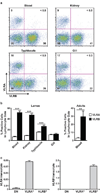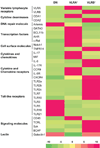Dual nature of the adaptive immune system in lampreys
- PMID: 19474790
- PMCID: PMC2714547
- DOI: 10.1038/nature08068
Dual nature of the adaptive immune system in lampreys
Erratum in
- Nature. 2009 Aug 20;460(7258):1044
Abstract
Jawless vertebrates use variable lymphocyte receptors (VLR) comprised of leucine-rich-repeat (LRR) segments as counterparts of the immunoglobulin-based receptors that jawed vertebrates use for antigen recognition. Highly diverse VLR genes are somatically assembled by the insertion of variable LRR sequences into incomplete germline VLRA and VLRB genes. Here we show that in sea lampreys (Petromyzon marinus) VLRA and VLRB anticipatory receptors are expressed by separate lymphocyte populations by monoallelic VLRA or VLRB assembly, together with expression of cytosine deaminase 1 (CDA1) or 2 (CDA2), respectively. Distinctive gene expression profiles for VLRA(+) and VLRB(+) lymphocytes resemble those of mammalian T and B cells. Although both the VLRA and the VLRB cells proliferate in response to antigenic stimulation, only the VLRB lymphocytes bind native antigens and differentiate into VLR antibody-secreting cells. Conversely, VLRA lymphocytes respond preferentially to a classical T-cell mitogen and upregulate the expression of the pro-inflammatory cytokine genes interleukin-17 (IL-17) and macrophage migration inhibitory factor (MIF). The finding of T-like and B-like lymphocytes in lampreys offers new insight into the evolution of adaptive immunity.
Figures





Comment in
-
Immunology: Immunity's ancient arms.Nature. 2009 Jun 11;459(7248):784-6. doi: 10.1038/459784a. Nature. 2009. PMID: 19516328 Free PMC article.
References
-
- Paul WE. Fundamental Immunology. Sixth Edition. Philadelphia: Lippincott Williams & Wilkins; 2008.
-
- Cooper MD, Peterson RD, Good RA. Delineation of the Thymic and Bursal Lymphoid Systems in the Chicken. Nature. 1965;205:143–146. - PubMed
-
- Roitt IM, Greaves MF, Torrigiani G, Brostoff J, Playfair JH. The cellular basis of immunological responses. A synthesis of some current views. Lancet. 1969;2:367–371. - PubMed
-
- Tonegawa S. Somatic generation of antibody diversity. Nature. 1983;302:575–581. - PubMed
-
- Yanagi Y, et al. A human T cell-specific cDNA clone encodes a protein having extensive homology to immunoglobulin chains. Nature. 1984;308:145–149. - PubMed
Publication types
MeSH terms
Substances
Grants and funding
LinkOut - more resources
Full Text Sources
Other Literature Sources
Miscellaneous

